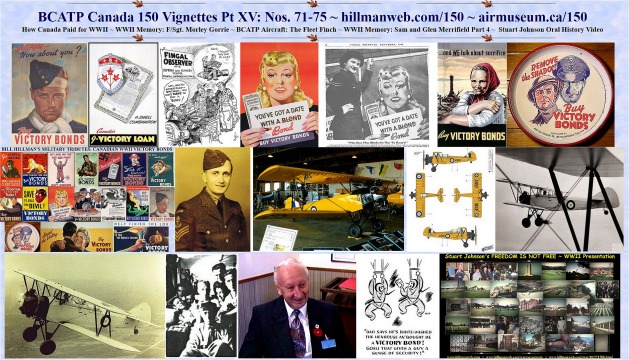074 of
150: A WWII Memory -- Sam and Glen Merrifield Part 4
Pocklington Summer
1941-rear: Sam Merrifield, McQueen, Jack Buller on bed
Jack Burnett, Tom Cranston, Bob Ford above ???, Paddy
Hughes down front.
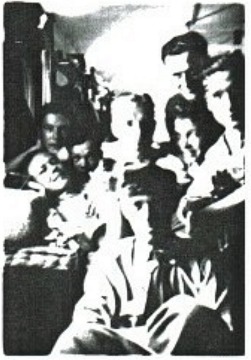 In
Part 4 of the Merriefield Brothers' recollection of their World War II
experiences, we find them settling into life in 405 Canadian Squadron of
the Royal Canadian Air Force in Pocklington, Yorkshire, England.
In this installment, Glen and Sam talk about life on the job with an operational
bomber squadron. It explores their duties as Wireless (Radio/Radar) Operator
Mechanics, their role and intereactions with their commanding officer and
details of a 405 Squadron mission to Germany.
In
Part 4 of the Merriefield Brothers' recollection of their World War II
experiences, we find them settling into life in 405 Canadian Squadron of
the Royal Canadian Air Force in Pocklington, Yorkshire, England.
In this installment, Glen and Sam talk about life on the job with an operational
bomber squadron. It explores their duties as Wireless (Radio/Radar) Operator
Mechanics, their role and intereactions with their commanding officer and
details of a 405 Squadron mission to Germany.
In our time at Driffield we had learned to do a DI (Daily
Inspection) on the wireless gear of a Wellington bomber. This was a relatively
simple procedure at or about aircrew technical requirement and no problem
for a Wireless Operator. However now we were at Pocklington with an operational
Squadron and required the expertise to install and repair the equipment
and Sam & I had not had this training. Two lads, Alec "Hutch" Hutcheon
and Norm "Roxy" Lawson arrived from Cranwell where they had been retrained
from WOGs Wireless Operator Ground) to WOMs Wireless Operator Mechanic),
the same course Jack Duller had been posted to take. This program was converting
Operators, no longer needed due to teleprinters, to Mechanics to staff
#6 Group which was being planned.
In mid-summer 1941 when Sam's posting to Cranwell for
the course arrived we went to the Padre and he had it cancelled so Sam
and I would not be separated. When mine arrived it was also cancelled.
We were LAC "B" Group WOGs and Hutch and Roxy were LAC "B" Group WOMs.
In the fall we were all sent to another drome to take a trade test to raise
the WOMs to "A" Group and see if Sam and I had learned enough to be rated
as WOMs. We all sat in a waiting room as Hutch, who was first in, came
out and gave us the thumbs down sign. Next Roxy gave the same. Sam went
in and also came out with negative results. I knew I didn't stand a prayer
so when I went in, I went on the attack. I asked the testing Sergeant how
come the RAF lads could join our section and be promoted through the 15
grades by our "Chiefie" (Flight Sergeant in command of a Technical Section
as opposed to an aircrew Flight Sergeant who was in command of only himself)
and we poor RCAF types had all this trade testing to go through. My point
was his theory covered the entire field, not just the equipment we used
on our aircraft and knew pretty well. I also pointed up we would get training
as equipment changed so why the need of a double standard? The outcome
was that he let his failure of the WOMs stand but agreed Sam and I would
be rated WOM "C" Group to allow us to stay with our buddies on the Squadron.
I think we went on one more formal trade test and made "B" Group. We were
later promoted to "A" Group at the Squadron. This was important as each
trade group rating made your pay increase 25 cents a day. It also made
us promotable to Corporal which was only open to "A" Group technicians.
This happened later but the next step to Sergeant never came as that would
have ended our "togetherness" as our Bomber Squadron only had one.
There were basically three types of airdromes occupied
by Bomber Command. The permanent bases, which Sam described previously,
of brick, centrally heated with the buildings and hangars in one Pocklington
Summer 1941 – rear – Sam Merrifield, McQueen, Jack Buller on bed, Jack
Burnett, Tom Cranston, Bob Ford above ???, Paddy Hughes down front.
The early wartime built dromes were similar except the
buildings were wooden or stucco construction, with no central heating.
Our heat was a small pot-bellied stove in each hut and the coal supply
was quite inadequate althogh we could get all the coke we wanted but had
no kindling and coke is very hard to start. This is the type of drome we
had at Pocklington. The third type were dispersed compounds of Nissen (Quonset
to North Americans) corrugated iron huts once again heated by the small
pot-bellied stove. Beaulieu and Gransden fell in the latter category. When
the U.S.A. came over they got an equal share of the good and the bad so
you can imagine they were not popular with the people who were moved from
a permanent base to the opposite to let them Yanks have the best.
My first recollection of "Pock" was sitting on the workbench
in our workshop which was in a lean-to row of workshops on the side of
a large hangar. This tremendous crash sounded and I was sure it was a bomb
and was half way across the hangar on the dead run when I noticed some
guys standing in the hangar doorway laughing at me. The noise I heard was
the only thunder I remember hearing in all my more than four years overseas.
A few days later in a hit and run raid we were bombed
but no damage except Bob Ford, our Sergeant, pulled a muscle climbing to
the top of the hangar to put out some Incendiary Bombs. During this period
Jerry and his bombs got to be a damned nuisance. Our drome was 20 miles
NW of Kingston-on-Hull which was bombed regularly, being a major coastal
port. We were the secondary target and any bombs that got hung up on Jerry's
run up over Hull came our way. What was worse was the fact that the Military
Police came to the sleeping quarters and insisted in their quaint way that
everyone go to the shelters. This caused us a lot of missed sleep and we
soon learned to make the best of it. This was done by putting your Wellingtons
(rubber boots to Canadians) next to your pants and your greatcoat, along
with your gas mask and tin hat in a quick grab position. When the air raid
siren sounded, you jumped up, put on your pants over your pyjamas, slipped
into your Wellingtons, put on your greatcoat, grabbed your tin hat and
gas mask and headed for shelter. If you got there in time to get a spot
where you could have a backrest you could doze a little, otherwise, tough
luck. This particular night I could not get comfortable in my corner .
It was pitch black and although something kept digging into my back I could
not find out what it was. When we returned to our billet and took off my
coat, the coat hangar fell on the floor... case solved.
One of Sam's 1980 anecdotes follows... It is fair to say
that, on balance, the ground crew on 405 Squadron; certainly in Driffield
and Pocklington days, may not have been outright disrespectful of rank
but neither did they hold a person in awe because of it. Those of us who
were in Driffield saw LAC's riding as tail gunner on some of the earliest
crews. Undoubtedly, we all respected and often envied them for the job
they were doing which certainly extended to the squadron and flight commanders.
We were for short periods commanded by a Flight Lieutenant and our Group
Captains arranged from that up to and including Group and in each case
the job that they were doing was the determining factor.
When Johnny Fauquier came to the squadron, he was a mere
flight lieutenant among ten or twelve others of that rank and all were
busy doing their thing. At or about that time, we were losing two or three
kites every time we flew on operations and with a compliment of some twenty-two
aircraft, including spares, of which a couple would be receiving periodic
inspections, it took only ten sorties (less than a month) to lose the equivalent
of the whole squadron. Additionally, at that time some of our senior crews
were being siphoned off to lend experience to the many other Canadian bomber
squadrons that were being formed in other parts of Yorkshire.
Thus, before Johnny had begun to show his metal, he ended
up as our squadron commander and for a very short time was still squadron
leader. In a couple of respects, he was a slow learner. Firstly, he did
not have his priorities correct with regard to aircrew vis-à-vis
ground crew. He had not yet learned that by virtue of their function, the
aircrews were short term squadron members whereas the ground crew was not
and whenever a ground crew member came before him on charge his prejudice
showed when he threw the book at them. His other problem was that he could
not shake his bushpilot habit of getting down to where he could see things
beneath him and so when coming home, he always dropped once he was over
the North Sea. One Night he came in contact with a barrage balloon cable
as he was crossing the coast above Hull. In one fell swoop he quickly learned
the value of keeping his aircraft up and of having hard working conscientious
ground crew personnel. Fortunately the cable cutters on the leading of
his mainplane worked like a charm and very little damage was done. From
that night on, "J" for johnny, LQ_J on her flanks, (the finest kite that
ever flew according to the scotch mechanic Jock Rose) stayed up where it
belonged until it got home and the members of the ground crew were
assured of a fair hearing and minimal punishment any time they came up
before Johnny on a charge... end of anecdote.
Johnny did two tours with us, One on mainforce at Pocklington
and one on Pathfinders at Gransden. He won the DSO and two bars and the
DFC. He was Canada's most decorated airman in the second World War and
the only Canadian in any service to win three DSOs. He ended the war as
an Air Commodore after a third tour as Commanding Officer of the Famous
Dambuster Squadron #617.
The Squadron's first daylight raid was on July 24, 1941.
The following is taken from the OPERATIONS RECORD BOOK:
BOMBING ATTACK ON "GNIESENAU" IN DRY DOCK - Pocklington
Operations Order No. 12 Aircraft H.V. & M. to carry cameras.
Bomb Load - 4 a/craft, 1 x 2000 A.P., 4 X 500 S.A.P., 5 a/craft 8x500 S.A.P.
Weather: excellent over target; no clouds, good visibility. Between 1532
- 1540 hours all our a/craft in the face of intense flak and fighter
opposition are known to have been over the target at an average height
of about 12000 ft. Owing to an error in the setting of the distributor
arm, one a/craft failed to release its bombs. One a/ craft definitely straddled
the cruiser, and all the a/craft bombed the target with success, some direct
hits being certain. One a/craft (S/Ldr Bisset) returned with fine photographs
of the target. The docks and surrounding districts were severally asted.
The GNIESENAU was enveloped in smoke from fires, both on target and on
the quays. "V" (Sgt Craig) was attacked in successive air battles by four
enemy a/craft, three M.E. 109's and one unidentified. Fine evasive action,
and return fire from the gunner (Sgt Higgins), and the front gunner, (Sgt
Hughes) accounted for two M.E .. The first M.E. broke off to attack "O"
(P/0 Trueman) the second, hit by Sgt Higgins, was seen to dive seaward,
it's engine in flames; the third enemy a/craft hit by two bursts from Sgt
Hughes, was seen to fall, tail down; the fourth was not seen, but bullets
penetrated the fuselage of "V" from its guns. The fabric of the fuselage
of "V" was on fire, and was extinguished by Sgt Alec Bain (WT/AG). With
extensive damage to the whole plane, with the rear turret out of action
and the gunner injured; and losing height to sea level, Sgt Craig made
for home, all the crew except the second pilot and himself at the tail
of the plane in order to weigh it down. 300 yards from land, the plane
made a crash landing in the sea. The crew made for shore in a Dinghy and
were picked up in a motor boat and taken ashore. Sgt Higgins was removed
to hospital injured. Only the tail of the plane appeared above water. "Q"
(Sgt Farmborough) was the plane of which the bombs were by error not released.
"Q" was attacked by a M.E.109 at 600 yards. At 100 yards it broke away
and "Q' s" rear gunner, F/Sgt Parsons fired forty rounds from each gun
into it's exposed belly. The enemy a/craft dived straight down. "L"(Sgt
Scott) had estimated a direct hit on the GNIESENAU with a 500 lb A.P. "L"
was attacked by a He 113 over Brest, but the enemy a/craft broke off the
engagement. From dead astern "L" was then attacked by an Me 109 and cannon
and M/G bullets pierced the fuselage. The rear gunner Sgt Dearnley, was
badly injured, and the a/craft suffered severe damage. A crash landing
was made at ROBOROUGH, and the machine was further damaged to extricate
Sgt Dearnley. He died later in hospital, Two of our a/craft, captained
by our Wing Commander and C.O., P.A. Gilchrist, D.F.C. and P/0 Trueman
were reported missing "0" (P/0 Trueman) was last seen diving steeply followed
by an ME 109. Photographs were taken as reported by "H", S/Ldr Bisset,
4 machines were lost, and 2 crews.
The Brest raid is remembered as our first 'biggie' and
losing the CO did not do much for the squadron image. I am pleased to report
that the W/C evaded capture and returned to the battle but not with our
squadron. He attended the 1970 reunion and lives in Toronto. Alec Bain
was a well liked WAG and our friendship with him went to the point of our
being invited to his home in Aberdeen when on leave there. One of my memories
of Pocklington was written up for the 1980 anecdotes and is as follows...
The Duke of Kent was the ranking Royalty that visited
the squadron early in the war. The King and Queen visited on January 10,
1944, but that is another story. His visit came at Pocklington not too
long before he was lost on a Scottish mountain in a Sunderland crash.
Now our hut was the closest to the Headquarters Building
and so we knew we were to be inspected when three were chosen as
that mornings "hut sluts" because we usually only had one. I was one so
nobly chosen and when we had the place spic and span the other two
decided to change to their best blues. Not me; I was, in my own view at
least; an old sweat, or at least older than the others. I stayed in my
working blues, dirty buttons and all and we stood at the head of the beds
as the entourage entered. Now the usual "ten-shun" etc. left us ram rod
stiff and the Duke headed straight for me. He asked where I was from,
how long I had been overseas etc.. As he spoke he put his foot up on the
bed frame and leaned his left elbow on his knee, very chummy like. Now
as I made my reply I noticed the Group Captain staring at me with eyes
on fire and I looked down to realize I had put my right foot up on
the bed frame and rested my right elbow on my knee to see eyeball to eyeball
with the Duke. Well I got it down real fast and the Duke smiled and I thought
I was for the jumps. I never heard a thing so have always felt the Duke
interceded on my behalf. He seemed a real good guy.
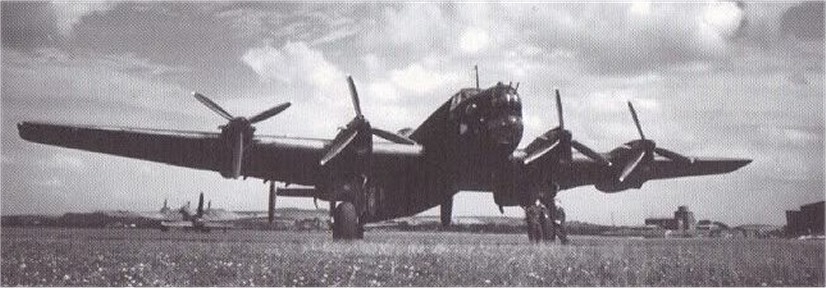
RCAF 405 Squadron Lancaster aircraft
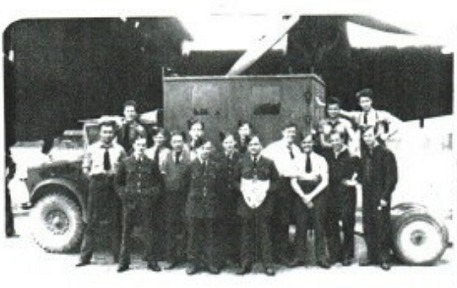
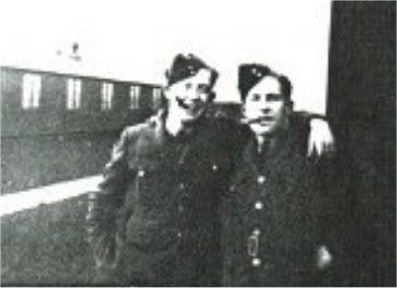
405 Squadron Wireless Section ~ Glen and Sam Merrifield at Pocklington
075 of
150: Stuart Johnson Oral History Video
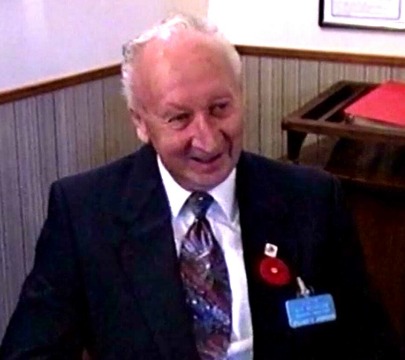 Stuart
Johnson is a long time member and volunteer at the Commonwealth Air Training
Museum. Stuart with wife Donna, visited hundreds of cemeteries where
World War II service men and women were buried or memorialized. They visited
almost every country in the world where military operations occurred during
World War II. With the wealth of knowledge and pictures collected from
these trips, Stuart and Donna made presentations to dozens of groups telling
the story of those who died together with important history for each location.
Stuart made many Remembrance Day presentations at the Commonwealth Air
Training Plan Museum.
Stuart
Johnson is a long time member and volunteer at the Commonwealth Air Training
Museum. Stuart with wife Donna, visited hundreds of cemeteries where
World War II service men and women were buried or memorialized. They visited
almost every country in the world where military operations occurred during
World War II. With the wealth of knowledge and pictures collected from
these trips, Stuart and Donna made presentations to dozens of groups telling
the story of those who died together with important history for each location.
Stuart made many Remembrance Day presentations at the Commonwealth Air
Training Plan Museum.
Stuart Johnson was too young to 'join-up' in World War
II and subsequently experienced it as a young boy living in rural Manitoba.
He had one sister who joined the Canadian Navy and two brothers who joined
the Royal Canadian Air Force, of which one was killed in action overseas.
Stuart sat down with staff at the museum in December 2000
to record his Oral History of World War II experiences. His video is a
collection of touching and informative remembrances covering many
topics including a family’s reaction to having a loved one in the armed
forces and losing a loved one to the war, how the armed forces in training
affected local life, rationing, collecting tin foil and other important
recyclable items to help Canada’s manufacturers produce essential war items
as well as other interesting stories.
Stuart Johnson’s 40 minute Oral History Video is a valuable
experience for us all. It can be seen on YouTube at:
https://www.youtube.com/edit?o=U&video_id=Q2z_fKy1OOI
Stuart has taken his camera to a multitude of European
battle sites and cemeteries to produce a remarkable one-hour slide show
entitled "Freedom is not Free." His presentation drives home the horrors
of war by featuring scenes of military cemeteries, concentration camps
and other historical sites related to WWI and WWII. Stuart's array of photographs
and well-researched, touching commentary combine to produce a fitting tribute
to those Canadians who gave us the freedom we enjoy today.
We are privileged to share with you here, a sampling of
some of the photos that Bill Hillman took during Stuart's presentation
at a CATP Museum Remembrance Day Service:
Stuart Johnson's FREEDOM IS NOT FREE
http://www.hillmanweb.com/war/2017/1708.html
The complete text of Stuart's Memorial Slide Presentation
is displayed at our accompanying script website.
Stuart Johnson's FREEDOM IS NOT FREE Script
http://www.hillmanweb.com/war/2017/1708a.html
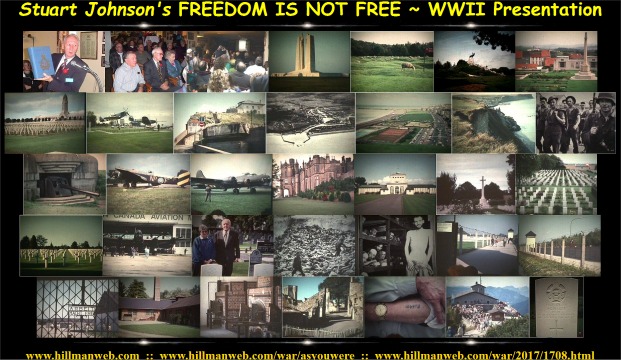
Click for full-size collage poster
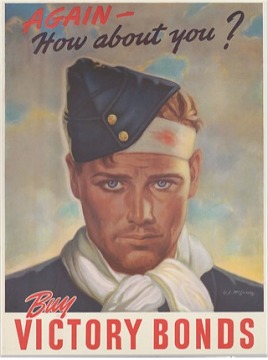
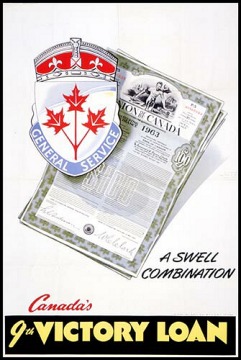
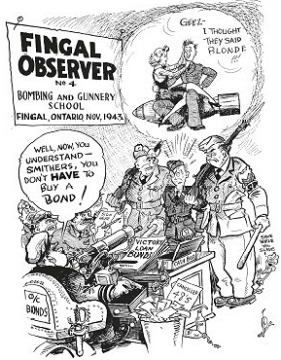

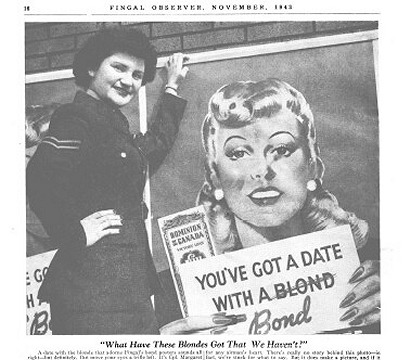

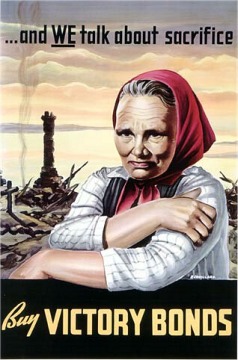 It
all reacted to the good of the campaign since it was the topic of conversation
for a few hours at least—until new blondes were put up.
It
all reacted to the good of the campaign since it was the topic of conversation
for a few hours at least—until new blondes were put up.
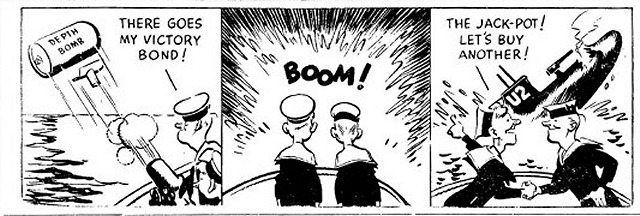
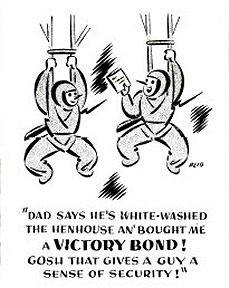
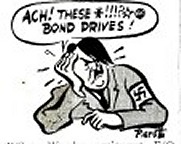
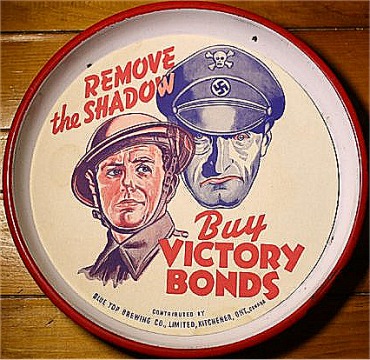 We
sure met a dumb cluck the other night. He thought that when he bought a
war bond he was contributing something to the cause. Like a donation to
the Red Cross, He thought he was "giving" instead of receiving. We said
right out loud: "look at this dumb bastard; he thinks he is GIViNG something,
instead of making a swell investment."
We
sure met a dumb cluck the other night. He thought that when he bought a
war bond he was contributing something to the cause. Like a donation to
the Red Cross, He thought he was "giving" instead of receiving. We said
right out loud: "look at this dumb bastard; he thinks he is GIViNG something,
instead of making a swell investment."
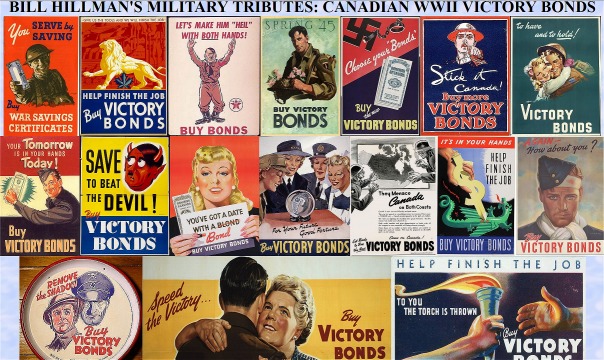
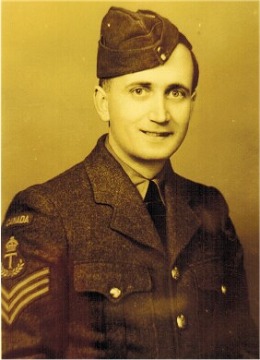 Morley
was married on June 6, 1942 to Edith Margaret Appleyard. In September of
1942 he enlisted and as he already had pharmaceutical training, he would
serve in that capacity with no further military training.
Morley
was married on June 6, 1942 to Edith Margaret Appleyard. In September of
1942 he enlisted and as he already had pharmaceutical training, he would
serve in that capacity with no further military training.
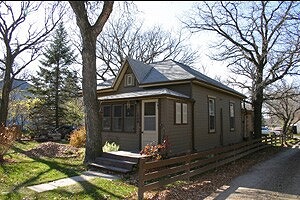 We
have a picture of the house where Morley and Edith lived in the 1940s.
We
have a picture of the house where Morley and Edith lived in the 1940s.
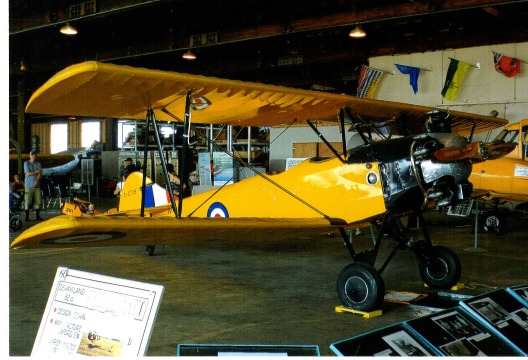 .
.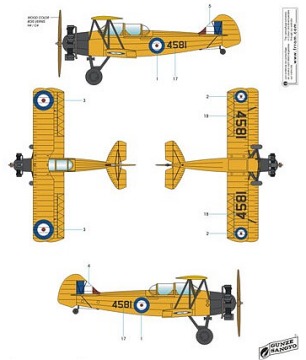
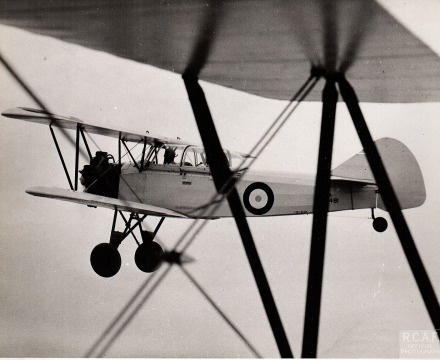 .
.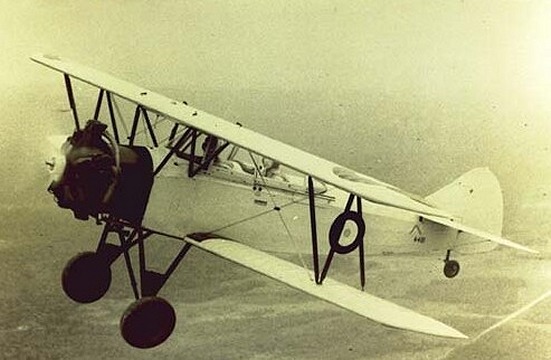
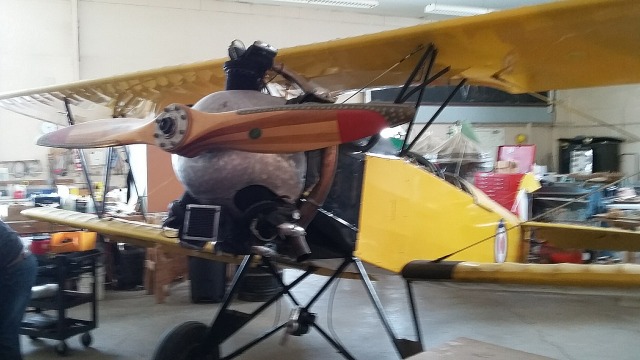
 In
Part 4 of the Merriefield Brothers' recollection of their World War II
experiences, we find them settling into life in 405 Canadian Squadron of
the Royal Canadian Air Force in Pocklington, Yorkshire, England.
In this installment, Glen and Sam talk about life on the job with an operational
bomber squadron. It explores their duties as Wireless (Radio/Radar) Operator
Mechanics, their role and intereactions with their commanding officer and
details of a 405 Squadron mission to Germany.
In
Part 4 of the Merriefield Brothers' recollection of their World War II
experiences, we find them settling into life in 405 Canadian Squadron of
the Royal Canadian Air Force in Pocklington, Yorkshire, England.
In this installment, Glen and Sam talk about life on the job with an operational
bomber squadron. It explores their duties as Wireless (Radio/Radar) Operator
Mechanics, their role and intereactions with their commanding officer and
details of a 405 Squadron mission to Germany.



 Stuart
Johnson is a long time member and volunteer at the Commonwealth Air Training
Museum. Stuart with wife Donna, visited hundreds of cemeteries where
World War II service men and women were buried or memorialized. They visited
almost every country in the world where military operations occurred during
World War II. With the wealth of knowledge and pictures collected from
these trips, Stuart and Donna made presentations to dozens of groups telling
the story of those who died together with important history for each location.
Stuart made many Remembrance Day presentations at the Commonwealth Air
Training Plan Museum.
Stuart
Johnson is a long time member and volunteer at the Commonwealth Air Training
Museum. Stuart with wife Donna, visited hundreds of cemeteries where
World War II service men and women were buried or memorialized. They visited
almost every country in the world where military operations occurred during
World War II. With the wealth of knowledge and pictures collected from
these trips, Stuart and Donna made presentations to dozens of groups telling
the story of those who died together with important history for each location.
Stuart made many Remembrance Day presentations at the Commonwealth Air
Training Plan Museum.

